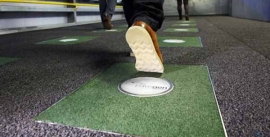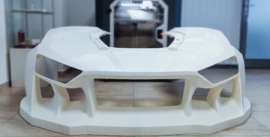 جدید
جدیدکوچکترین موتور جهان برای ورود به سلول های زنده 2016 World’s tiniest engine
کوچکترین موتور جهان برای ورود به سلول های زنده
کوچکترین موتور جهان برای ورود به سلول های زنده
[box type=”shadow” align=”alignright” ]پژوهشگران یک نانوموتور ساخته اند که میتواند اساس مربوط به کاربردهای آتی در نانوروباتیک شامل روبات هایی به اندازه کافی کوچک برای ورود به سلول های زنده را تشکیل دهد. [/box]
[box type=”success” width=”1024″ ] ترجمه از گروه ترجمه ایران مواد
حرفه ای ترین تیم ترجمه مهندسی مواد کشور
[/box]
پژوهشگران کوچکترین موتور جهان یعنی فقط به اندازه چند میلیاردیم متر را ساخته اند که از نور برای انرژی دهی به خود استفاده می کند. موتور نانومقیاس ایجاد شده توسط پژوهشگران در دانشگاه کمبریج، می تواند پایه ای برای نانوماشین های آتی باشد که قادر به پیمایش در آب، حس کردن محیط پیرامون یا حتی ورود به سلول های زنده برای مبارزه با بیماری ها باشند.
نمونه اولیه ابزار از ذرات کوچک باردار طلا که با پلیمرهای پاسخ دهنده به دما به صورت ژل بهم پیوند خورده اند ساخته شده است. هنگامی که نانوموتور تا دمایی معین با یک لیزر گرما داده می شود، پوشش های پلیمری همه آب را از ژل پس زده و فرو می ریزند و نانوموتور مقادیر زیادی انرژی الاستیک در کسری از ثانیه ذخیره می نماید. این موضوع باعث می شود که نانوذرات طلا به هم پیوند بخورند و به شکل خوشه هایی سفت و محکم در آیند. اما هنگامی که این ابزار خنک می شود پلیمرها آب گیری نموده و منبسط می شوند و نانوذرات طلا بشدت و بسرعت مانند یک فنر از هم باز شوند . نتایج در مجله PNAS گزارش شده اند.
دکتر تائو دینگ از آزمایشگاه کاوندیش کمبریج و نویسنده اول مقاله می گوید: این فرایند شبیه به یک انفجار است. هنگامی که مولکول های آب، پلیمرهای اطرافشان را متورم می کنند ما صدها گلوله طلا داریم که در یک میلیونیم ثانیه شکسته شده و تکه تکه می شوند.
دکتر ونتسیسلاو والف دیگر نویسنده مقاله از دانشگاه بث (Bath) می گوید: ما می دانیم که نور می تواند آب را برای تامین انرژی موتورهای بخار گرم کند اما اکنون ما می توانیم از نور برای تامین انرژی یک موتور پیستونی در مقیاس نانو استفاده نماییم.
نانوماشین ها برای مدت ها، رویای دانشکندان و مردم بوده است اما از آنجا که راه های برای ساختن واقعی آنها هنوز باید توسعه یابند، این ماشین ها در قلمرو افسانه های علمی باقی مانده اند. روش جدید ایجاد شده توسط پژوهشگران کمبریج بطور غیرقابل توجهی ساده اما بسیار سریع است و نیروهای بزرگی اعمال می کند.
نیروهای اعمال شده توسط این ابزار های کوچک چند بار بزرگ تر از نیروهای اعمال شده توسط دیگر ابزار های تولید شده است که مقدار نیرو در واحد وزن تقریبا 100 برابر بهتر از هر موتور یا ماهیچه دیگر است. بر اساس یافته های این پژوهشگران، این ابزارها، همچنین زیست سازگار، مقرون به صرفه برای تولید شدن، سریع پاسخ و با بازدهی انرژی می باشند.
پروفسور جرمی بائومبرگ از آزمایشگاه کاوندیش که سرپرستی پژوهش را برعهده داشت این ابزار را ANT یا نانومبدل های برانگیزاننده نامیده است. وی می گوید: مانند مورچه های واقعی، این ابزارها نیروهای بزرگی در مقابل وزن خود تولید می کنند. چالشی که ما اینک با آن مواجهیم چگونگی کنترل آن نیرو برای کاربرد در نانو ماشین ها می باشد.
این پژوهش چگونگی تبدیل انرژی واندروالس- جاذبه بین اتم ها و مولکول ها را به انرژی الاستیک در پلیمرها و آزادسازی سریع آن را بیان می دارد. بائومبرگ می گوید: کل فرایند شبیه یک نانوفنر است. بخش هوشمندانه آن در اینجا این است که ما از جاذبه واندروالس ذرات سنگین فلز برای تنظیم فنرها (پلیمرها) و از مولکول های آب برای آزاد کردن آنها استفاده می کنیم. این کار بسیار برگشت پذیر بوده و قابلیت انجام مجدد را دارد.
این گروه در حال حاضر مشغول کار با بخش سرمایه گذاری کمبریج (Cambridge Enterprise)،بازوی تجاری سازی دانشگاه کمبریج، و تعدادی شرکت دیگر با هدف تجاری سازی این فناوری برای زیست کاربری های میکروسیالی می باشند.
[box type=”info” align=”alignright” width=”1124″ ]منبع : sciencedaily.com
ترجمه : محسن حاجی زمانی [/box]
[divider]
World’s tiniest engine small enough
to enter living cells
Researchers have developed the world’s tiniest engine — just a few billionths of a metre in size which uses light to power itself. The nanoscale engine, developed by researchers at the University of Cambridge, could form the basis of future nano-machines that can navigate in water, sense the environment around them, or even enter living cells to fight disease.
The prototype device is made of tiny charged particles of gold, bound together with temperature-responsive polymers in the form of a gel. When the ‘nano-engine’ is heated to a certain temperature with a laser, it stores large amounts of elastic energy in a fraction of a second, as the polymer coatings expel all the water from the gel and collapse. This has the effect of forcing the gold nanoparticles to bind together into tight clusters. But when the device is cooled, the polymers take on water and expand, and the gold nanoparticles are strongly and quickly pushed apart, like a spring. The results are reported in the journal PNAS.
“It’s like an explosion,” said Dr Tao Ding from Cambridge’s Cavendish Laboratory, and the paper’s first author. “We have hundreds of gold balls flying apart in a millionth of a second when water molecules inflate the polymers around them.”
“We know that light can heat up water to power steam engines,” said study co-author Dr Ventsislav Valev, now based at the University of Bath. “But now we can use light to power a piston engine at the nanoscale.”
Nano-machines have long been a dream of scientists and public alike, but since ways to actually make them move have yet to be developed, they have remained in the realm of science fiction. The new method developed by the Cambridge researchers is incredibly simple, but can be extremely fast and exert large forces.
The forces exerted by these tiny devices are several orders of magnitude larger than those for any other previously produced device, with a force per unit weight nearly a hundred times better than any motor or muscle. According to the researchers, the devices are also bio-compatible, cost-effective to manufacture, fast to respond, and energy efficient.
Professor Jeremy Baumberg from the Cavendish Laboratory, who led the research, has named the devices ‘ANTs’, or actuating nano-transducers. “Like real ants, they produce large forces for their weight. The challenge we now face is how to control that force for nano-machinery applications.”
The research suggests how to turn Van de Waals energy — the attraction between atoms and molecules — into elastic energy of polymers and release it very quickly. “The whole process is like a nano-spring,” said Baumberg. “The smart part here is we make use of Van de Waals attraction of heavy metal particles to set the springs (polymers) and water molecules to release them, which is very reversible and reproducible.”
The team is currently working with Cambridge Enterprise, the University’s commercialisation arm, and several other companies with the aim of commercialising this technology for microfluidics bio-applications.
The research is funded as part of a UK Engineering and Physical Sciences Research Council (EPSRC) investment in the Cambridge NanoPhotonics Centre, as well as the European Research Council (ERC).









دیدگاه کاربران